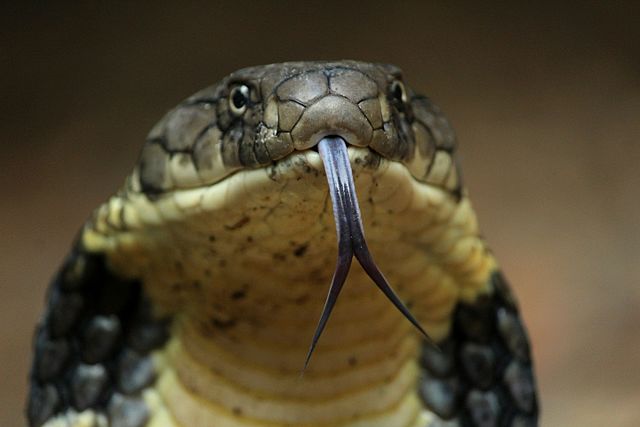Here are the top 10 Rattlesnake Facts For Kids which will provide you with a brief overview of this unique snake.
- A rattlesnake is a viper with a unique segmented structure at the end of its tail that produces a rattling sound when the snake vibrates its tail.
- They have a heat-sensing organ called “pit” which helps them in locating their prey.
- They have a lifespan of 10 to 25 years.
- Rattlesnakes have sharp curved fangs that they shed after every 6 to 10 weeks.
- There are 30 species of rattlesnake.
- They are among the world’s most recently evolved snakes.
- Their diet consists of small animals like rodents, small birds, and other small invertebrates.
- Rattlesnakes are endemic to the Americas only.
- During winter, some species of rattlesnakes enter a period of dormancy, called brumation.
- The bites of rattlesnakes are dangerous but not deadly due to improved treatment methods.
Rattlesnake Facts For Kid
What Is A Rattlesnake
- Rattlesnakes are a group of large venomous snakes native to North and South America.
- They belong to two genera; Crotalus and Sistrurus.
- The number of known species of rattlesnakes is more than 30, and subspecies are between 65 and 70.
- They belong to the subfamily Crotalinae and are also known as Pit Vipers or New World Vipers.
- Rattle (a segmented hollow organ at the tip of the tail that produces warning sound upon vibration) is the most distinctive feature of all the rattlesnake species.
- Having a “pit” (a heat-sensitive organ at both sides of the head) is another most distinctive feature of the rattlesnakes, which they use for locating prey.

Rattlesnake Meaning
- Rattlesnake means a heavy-bodied pit viper found only in the Americas. It has a characteristic segmented structure at the end of the tail, which produces a special sound upon vibration.
What Do Rattlesnakes Look Like – Rattlesnake Appearance For Kids
- Rattlesnakes are one to eight feet long (depending on the species) snakes with thick and heavy bodies.
- They have triangular or diamond-shaped heads.
- Their bodies are covered with ridged (keeled) scales of various colors and patterns. Most species have dark patterns of diamonds, hexagons, or rhombuses on the light background.
- They have large flexible jaws and hinged fangs (that remain folded when not in use).
- They have a heat-sensing organ known as a pit on the head, which looks like a spot between the eyes and the nostrils.
- Their eyes have vertical pupils like that of the cats.
- On the tip of their tail, rattlesnakes have a rattle or partial rattle. A rattle is doughnut-like interlocking hollow rings or segments, made up of keratin (the same protein that makes our nails).
- When the segments of rattle band together, it creates a hissing noise.
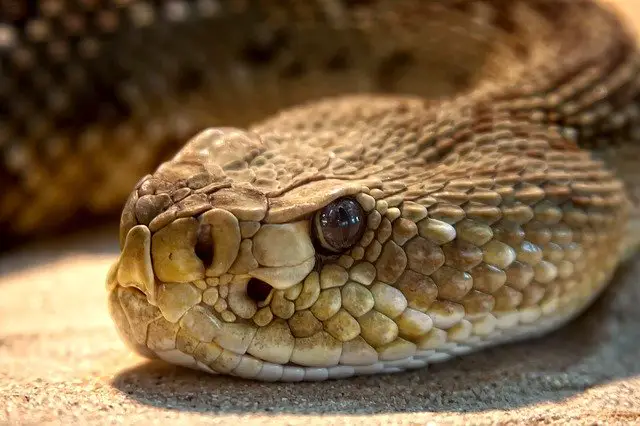
Rattlesnake Scientific Classification
- The following is the scientific classification or taxonomy of rattlesnake:
| Kingdom | Animalia |
| Phylum | Chordata |
| Subphylum | Vertebrata |
| Class | Reptalia |
| Order | Squamata |
| Sub-order | Serpentes |
| Family | Viperidae |
| Sub-family | Crotalinae |
| Genera | Crotalus Sistrurus |
How Much Do Rattlesnakes Weigh – Rattlesnake Weight
- The eastern diamondback rattlesnake (Crotalus adamanteus) is the heaviest of all the rattlesnake’s species. It has a bodyweight from 1.8 to 4.5 kg (4 to 10 pounds).
- The ridge-nosed rattlesnake is the lightest of all the rattlesnake species, with a bodyweight of only 85 to 114 grams (3 to 4 ounces).
How Long Is A Rattlesnake – Rattlesnake Length
- According to the Wildlife Federation, the length of rattlesnake species ranges from 1 to 8 feet.
- With up to 8 feet (2.4 meters) body length, the eastern diamondback rattlesnake (Crotalus adamanteus) is the longest of all the rattlesnakes.
- Twin-spotted rattlesnake (Crotalus pricei) is the shortest of all the rattlesnake species and has about 12 inches (1 foot) length.
- Most species have a body length from 2 to 4 feet (0.6 to 1.2 meters).
How Long Do Rattlesnakes Live – Rattlesnake Lifespan
- According to San Diego Zoo, the lifespan of rattlesnakes is 25 years.
- According to the National Wildlife Federation, the lifespan of rattlesnakes is 10 to 25 years.
- They may live for a maximum age of about 30 years.
- In captivity, 10 rattlesnake species lived for 20 to 30 years.
How Fast Are Rattlesnakes – Rattlesnake Speed
- The speed of rattlesnakes is not measured specifically.
- However, they probably travel at the fastest speed of 2 to 3 miles per hour for short bursts.
Rattlesnake Fangs Facts For Kids
- Rattlesnakes have sharp curved fangs similar to curved hypodermic needles.
- Venom ducts connect the fangs to large venom glands at the top edge of the upper jaw.
- The base of the fangs and the ending part of the venom ducts are surrounded by soft tissue, which also prevents leakage.
- During the bite, the contraction of muscles at the sides of the venom gland allows the venom to squeeze through the ducts and into the fangs.
- The fangs remain folded parallel to the palate when not in use.
- Hatchlings are born with fully functioning fangs.
- Adult rattlesnakes periodically shed their fangs after every 6 to 10 weeks.
- Behind every functional fang is a series of 7 developing fangs.
- The size of fangs depends on the species size of the rattlesnake. However, large rattlesnakes have about 4 to 6 inches (10 to 15 cm) long fangs.
Types Of Rattlesnakes – Rattlesnake Species – Rattlesnake Representative Species
- There are more than 30 known species of rattlesnakes. 34 species or types of rattlesnakes are described in the following table:
| S.No | Species Common Name | Scientific Name |
| 1 | Western diamondback rattlesnake | Crotalus atrox |
| 2 | Timber rattlesnake | Crotalus horridus |
| 3 | Massasauga | Sistrurus catenatus |
| 4 | Eastern diamondback rattlesnake | Crotalus adamanteus |
| 5 | Mojave green | Crotalus scutulatus |
| 6 | Pygmy rattlesnake | Sistrurus miliarius |
| 7 | Prairie rattlesnake | Crotalus viridis |
| 8 | Northern Pacific rattlesnake | Crotalus oreganus |
| 9 | South American rattlesnake or tropical rattlesnake | Crotalus durissus |
| 10 | Sidewinder | Crotalus cerastes |
| 11 | Arizona black rattlesnake | Crotalus cerberus |
| 12 | Black-tailed rattlesnake or green rattler | Crotalus molossus |
| 13 | Tiger rattlesnake | Crotalus tigris |
| 14 | Red diamond rattlesnake | Crotalus ruber |
| 15 | Rock rattlesnake | Crotalus lepidus |
| 16 | Dusky rattlesnake | Crotalus triseriatus |
| 17 | Mexican lance-headed rattlesnake | Crotalus polystictus |
| 18 | Middle American rattlesnake or Central American rattlesnake | Crotalus simus |
| 19 | New Mexican ridge-nosed rattlesnake | Crotalus willardi |
| 20 | Speckled rattlesnake | Crotalus mitchellii |
| 21 | Totonacan rattlesnake | Crotalus totonacus |
| 22 | Autlán rattlesnake | Crotalus lannomi |
| 23 | Mexican west coast rattlesnake, Mexican green rattler | Crotalus basiliscus |
| 24 | twin-spotted rattlesnake | Crotalus pricei |
| 25 | Santa Catalina rattlesnake | Crotalus catalinensis |
| 26 | Mexican pygmy rattlesnake | Crotalus ravus |
| 27 | Baja California rattlesnake, Lower California rattlesnake | Crotalus enyo |
| 28 | Querétaro dusky rattlesnake | Crotalus aquilus |
| 29 | Cross-banded mountain rattlesnake | Crotalus transversus |
| 30 | Mexican small-headed rattlesnake | Crotalus intermedius |
| 31 | Isla Angel rattlesnake | Crotalus angelensis |
| 32 | Tancitaran dusky rattlesnake | Crotalus pusillus |
| 33 | long-tailed rattlesnake | Crotalus stejnegeri |
| 34 | Tortuga Island rattlesnake or Tortuga Island diamond rattlesnake | Crotalus tortugensis |
Rattlesnake Tail
- The tail of rattlesnakes ends on a special hollow segmented structure, known as a rattle.
- The scales covering the tip of the tail are modified to the rattle.
- The rattle is made up of keratin, the same protein that also makes human nails.
- The tail has special “shaker” muscles. Upon contraction, these muscles cause the rattle’s segments to vibrate against one another, producing a sound known as rattling noise.
- The sound is amplified due to the hollow structure of the segments.
- When the snake sheds its skin (molts), a segment is added to its rattle. They usually shed their skin three to four times a year.
- However, the number of the rattle segments can not describe the age of a rattlesnake, because the end segment is regularly break-off due to their daily activities.
- The newborn rattlesnakes have a button-like shape at the tip of their tail and develop functioning rattles after shedding skin about two times.
- The tail of the male rattlesnake is longer and thicker than female’s because their tail contains inverted hemipenes.

Rattlesnake Sound
- Rattlesnakes make hissing sounds with their rattles.
- The famous rattle sounds are created when bony and hollow segments of the rattle band together.
What Did Rattlesnakes Evolve From
- Rattlesnakes are believed to be the world’s newest and most recently evolved snakes.
- The evolution of rattlesnakes occurred about 12 to 14 million years ago.
- It is believed that the ancestor of the modern rattlesnake was a large snake or serpent. The ancestor snake had the genes to produce the venom that would target the muscles, the blood, as well as nervous system.
- During evolution, the ancestors of the rattlesnakes deleted the genes rapidly that were responsible for the production of diverse toxins. It caused the faster-than-usual evolution of the rattlesnakes.
- It is also believed that before evolving rattle, rattlesnakes had silently shaken their tail.
- A study suggests that the rattle evolved a long time after their tail-shaking behavior.
What Do Rattlesnakes Eat – Rattlesnake Diet
- Rattlesnakes eat small animals like rodents (rats and mice), small birds, and other types of small animals (such as invertebrates) as a major part of their diet.
- Rattlesnakes either hunt the prey in the holes or lie in wait until the prey passes near.
- They quickly kill the prey with a venomous bite.
- If the bitten prey escapes before dying, they follow it using its acute sense of smell.
- Once the bitten prey is located, the rattlesnakes prod it with their snout and smell it with their nostrils and tongue to check if it is dead or still alive.
- They then locate the head of the immoveable prey and then ingest it with the head-first direction.
- Rattlesnakes have extremely powerful gastric fluid, which not only digests the flesh but also bones.
- Rattlesnakes continue hunting if the prey is small. In case of an adequate hunt, they find a safe and warm place to coil up until the digestion of the prey.
- When the body temperature of the rattlesnake is between 25 and 29 °C (80 and 85 °F), they have an optimal digestion rate.
- To remain hydrated, rattlesnakes also drink a large amount of water annually.
What Do Baby Rattlesnakes Eat
- Baby and young rattlesnakes eat lizards as a major part of their diet.
How Much Does A Rattlesnake Eat In A Day
- Like other snakes, rattlesnakes also have a low metabolic rate.
- If their prey was small, they would hunt many times until their stomach became full.
- The digestion of a big meal takes several days and the snake becomes sluggish during this period and hides in a safe and warm location.
- Adult rattlesnakes are described to eat about every two weeks if their previous meal was big.
Rattlesnake Food Chain
- The following is the food chain of rattlesnakes:
- Sun is the overall energy source in this food chain.
- Producers are plants, which take energy from the sun and prepare their food themselves.
- Primary consumers are rodents, such as rats and mice, that consume plants and grains.
- Secondary consumer in this food chain is the rattlesnake that consumes rodents.
- Tertiary consumers are hawks, eagles, raccoons, coyotes, and other snakes, which prey on rattlesnakes.
- Decomposers are bacteria, ants, and other organisms found in the soil. They decompose the dead matter of the primary, secondary, and tertiary consumers and make the soil fertile for the growth of plants (producers).
Where Do Rattlesnakes Live – Rattlesnake Habitat
- Rattlesnakes are endemic to the Americas, where they are found from southwestern Canada to central Argentina.
- A large majority are found in Mexico and American Southwest.
- In the east of the Mississippi River, four species of rattlesnakes may be found. While two species are found in South America.
- Texas and Arizona are two states in the United States, where most types of rattlesnakes are found.
- Rattlesnakes are found in diverse habitats, almost every type of habitat that can support terrestrial ectothermic vertebrates. (Ectothermic animals are animals whose body depends on external heat sources to regulate their temperature. They are also known as cold-blooded).
- However, the habitat requirements of individual rattlesnakes species can be extremely specific.
- Most species are found near open rocky regions. Rocks shelter them from predators, basking areas, as well as plentiful prey.
- They prefer to live in undisturbed natural habitats, and usually avoid developed areas.
- Besides rocky areas, they can also live in a variety of other habitats, such as deserts, marshes, forests, and prairies.
- They prefer to live in the temperature range between 26 and 32 °C (80 and 90 °F). They can survive brief exposure to below-freezing temperatures as low as -16 °C (4 °F). They can live for several days in temperatures as low as 3 °C (37° F).
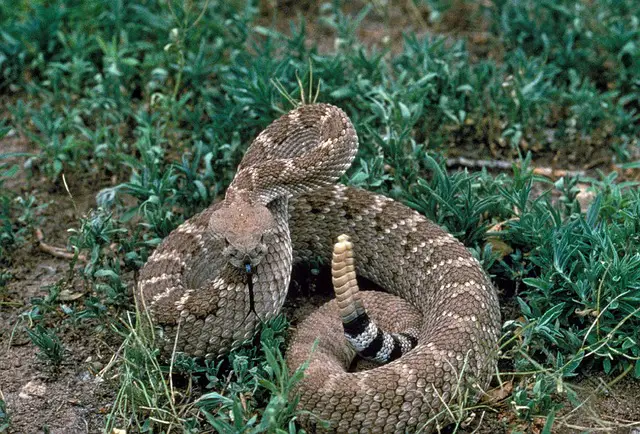
Rattlesnake Nesting Habits – Where Do Rattlesnakes Sleep- Rattlesnakes Hibernation
- During the colder months of winter, some species of rattlesnakes enter a period of dormancy, which is known as brumation. Brumation is similar to the hibernation of other animal species.
- For brumation, a large number of rattlesnakes usually get together in an underground den, known as rattlesnake dens or hibernacula.
- Sometimes, the number of snakes may be more than 1,000 and they huddle together inside the den.
- They share their dens with various other types of animal species, such as other types of snakes, small mammals, turtles, and invertebrates.
- Rattlesnakes often use the same den for years. According to the San Diego Zoo, the same den is sometimes used for more than 100 years. The South Dakota Game, Fish, and Parks Department reported that generations of the rattlesnakes will use the same den. They sometimes travel a distance of several miles to get there.
- The reproduction rate in the species with a longer brumation period is lower than those with no brumation or short brumation periods.
- Rattlesnakes also spend the hot and dry periods of summer in dormancy like most of the other snakes. That is why they are rarely observed during the hot and dry summer months.
Where Do Rattlesnakes Hide
- Rattlesnakes can not tolerate extreme conditions of cold or heat (as like other reptiles, they are cold-blooded).
- In the warm summer days, they hide under rocks or in underground burrows.
- During the colder months of winter, some rattlesnake species congregate in the dens, which are underground burrows or rock slides where they hibernate.
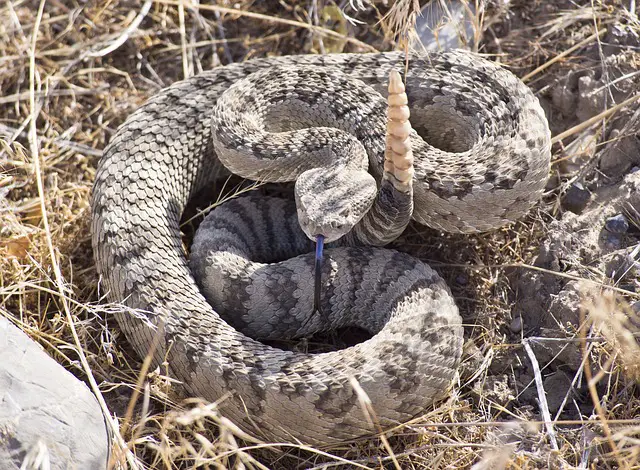
Rattlesnake Venom Facts For Kids
- The venom of rattlesnakes is a mixture of proteins, free amino acids, biogenic amines, lipids, 5 to 15 enzymes, and various metal ions.
- Their venom also has components that are specially evolved to immobilize and disable the prey.
- Their venom also contains digestive enzymes, which cause the breakdown of the tissue to prepare food for later ingestion.
- The venom of the rattlesnakes is hemotoxic and causes coagulopathy (disruption of the blood clotting). It also destroys the tissue and causes necrosis (complete damage of the tissues).
- The venom of some species (such as the U.S tiger rattlesnake, and some varieties of the Mojave rattlesnake) have a component called Mojave to type A toxin. This component is presynaptic neurotoxic and causes severe paralysis.
- The venom of older rattlesnakes is more potent than that of the younger.
- The venom of rattlesnakes has higher stability. In storage, its toxicity remains for many years.
Rattlesnake Reproduction
- Rattlesnakes reproduce through the Ovoviviparous mode of reproduction, in which the eggs hatch inside the female’s body and she then gives birth to live young.
- The female rattlesnakes usually reproduce once every three years.
- The females secrete sex pheromones, which leave a trail for males.
- The males use their tongue and Jacobson’s organs and follow the females.
- The mating season of some rattlesnake species is summer or fall, some species mate only during the spring, while some species mate during both spring and fall.
- The ovaries of the female produce eggs (ova). The eggs travel through the body cavity and into one of her two oviducts.
- The male reproductive organ is located in the base of its tail and is known as hemipenes.
- Upon mating, the fertilization of the eggs occurs inside the female’s body.
- In the late summer season, the females give birth offspring in the form of a group known as brood after the gestation period of about 3 months.
- A brood has an average number of 4 to 10 young. However, the brood may have 1 to 60 numbers of young.
- In most species, the mothers leave as soon as babies are born and do not spend any time with them.
- In some species (such as the Arizona black rattlesnake), the mothers remain with their young for several weeks.
- In some species, the mothers are also observed parenting their broods cooperatively.
Rattlesnake Life Cycle
- The life cycle of rattlesnakes starts when they reach sexual maturity.
- They generally take about two years to become mature.
- Upon mating, the eggs inside the female fertilize and then hatches.
- The females then give birth to a brood of living young after a gestation period of about 90 days.
- The babies take several years to mature depending on the availability. According to San Diego Zoo, babies mature at the age of 18 months to 2 years.
- The lifespan of 10 rattlesnake species was 20 to 30 years in captivity.
Rattlesnake Baby Facts – Rattlesnakes Hatching
- A baby rattlesnake is known as a hatchling.
- The hatchlings have functioning fangs and potent venom like that of adults.
- Depending on the species, the hatchlings are 18 to 38 cm (7 to 15 inches) long at birth.
- Baby rattlesnakes are born with a “pre-button” at the end of their tail.
- After several days of their birth, it is replaced by a “button” like structure when they shed their skin for the first time.
- When they shed their skin again, they develop about two rattle segments.
- Once they develop three rattle segments, they can produce the buzz sound like that of adults.
Are Baby Rattlesnakes Born With Rattlers
- No, baby rattlesnakes are not born with rattles.
- They have only a button-like shape at the end of their tail.
Rattlesnake Adaptations
The following are the major adaptations of the rattlesnakes:
Heat-sensing pits
- Having heat-sensing pits is an important adaptation of rattlesnakes, which makes them capable of locating their prey.
- Rattlesnakes have a set of heat-sensing pits on their faces, which allows them to detect thermal radiations emitted from the bodies of warm-blooded organisms in their surroundings.
- A pit optically functions like the eye of a pinhole camera. Thermal radiation passes through the pit opening in the form of infrared light. The light then strikes the pit membrane in the back wall and warms it. The membrane has a high density of heat-sensitive receptors, due to which a rattlesnake can detect less than 0.003 °C temperature changes in its close surroundings.
Eyes
- Rattlesnakes have well-adapted eyes for nocturnal use, as they have many rod cells.
- But rattlesnakes are not completely nocturnal and have a more sharp vision during daylight.
- Their eyes also have cone cells, which means they can see some colors.
- They mostly depend on movement perception as fovea is absent in their eyes, and they can not see sharply defined images.
Sense of smell
- The extremely keen sense of smell of the rattlesnakes is an important adaptation.
- They can smell through their nostrils, as well as through their forked tongues, which transfer scent-bearing particles to the Jacobson’s organs located at their palate.
- A keen sense of smell allows them to locate prey and predators from a large distance.
Hearing system
- Like other snakes, rattlesnakes do not have external ear openings and also do not have a highly specialized middle ear.
- So they do not have a well-effective hearing sense.
- However, they can sense ground vibrations, which pass to their auditory nerve through the skeleton.
- Sensing the ground vibrations allows them to avoid predators and to find prey.
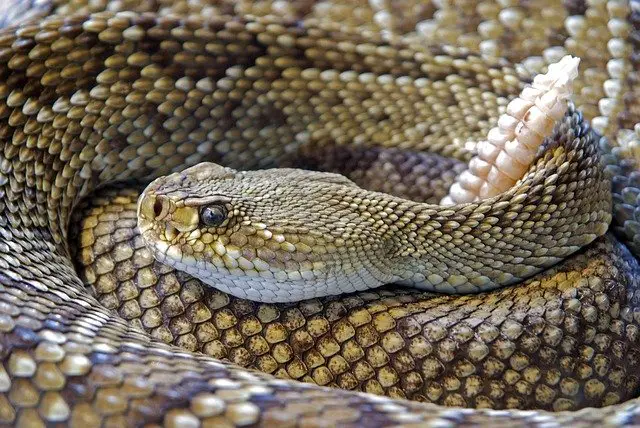
Fangs
- Rattlesnakes have curved fangs. The fangs have a connection with the venom glands through the venom ducts. They use their fangs to inject venom and kill prey.
Venom
- The toxic venom of the rattlesnakes causes the immobilization and disability of the prey.
- Digestive enzymes in the venom also cause the breakdown of the prey tissue and prepare it for later ingestion.
Skin
- Rattlesnakes have well-adapted skin and circulation.
- Their entire body skin is covered by a set of overlapping scales.
- It provides them protection against a variety of threats, such as physical injuries and dehydration.
- Their skin is also extremely sensitive to touch, pressure, and tension, as well as they, can feel pain.
Body color
- Rattlesnakes have brown, sandy, khaki, black, and grey collars of their body, which resembles the surrounding environment.
- Their skin also has complicated patterns.
- Their skin color and patterns are excellent camouflage against predators.
What Eats Rattlesnakes – Rattlesnake Predators
- Newborn rattlesnakes are extremely vulnerable and many animal species prey on them.
- The predator animals include raccoons, opossums, coyotes, skunks, weasels, roadrunners, ravens, crows, racers, king snakes, and whip snakes.
- Small predatory birds like kingfishers, shrikes, and jays prey the neonates of smaller rattlesnake species.
- Some ant species in the genus Formica and fire ants (Solenopsis Invicta) also prey on the neonates of rattlesnakes.
- Sometimes, adult rattlesnakes also eat the neonates when they are hungry.
- Only a small proportion of the newborn rattlesnakes pass their first birthday, often only about 20%. In this age, a variety of large predators heavily hunt them, such as coyotes, feral, badgers, pigs, indigo snakes, falcons, eagles, hawks, and owls.
- The most common predator of adult rattlesnakes is the common kingsnake (Lampropeltis getula), which is immune to the venom of the rattlesnake as well as other vipers.
- Rattlesnakes detect the presence of common kingsnakes through their scent.
- Rattlesnakes make a defensive posture known as ‘body bridging’ upon facing the common kingsnake.
- The rattlesnake twists its body and forms an elevated coil that faces the predator. The elevated coil is used as a shield to protect the head (as snakes first ingest the head of the prey) as well as to strike the attacker.
Are Rattlesnake Bites Deadly – Rattlesnake Bite
- The bites of rattlesnakes are dangerous, however, it is no longer deadly to humans because of improved treatment methods.
- In the United States, the estimated number of people annually bitten by venomous snakes is 7,000 to 8,000, with about five fatalities.
- To humans, the bites of rattlesnakes are very rarely fatal.
- In case of severe envenomation, the survival of the victim depends on the time passed between the bite and the treatment.
- Most of the deaths occur between 6 and 48 hours after the bite.
- If a victim receives antivenom treatment within two hours of the bite, the possibility of his recovery is higher than 99%.
- About 20% of rattlesnake bites are ‘dry bites’ and cause no envenomation.
Rattlesnake Venom Type
- Most species of rattlesnakes have a hemotoxic type of venom, which disrupts blood clotting and causes severe blood loss and internal bleeding.
- The venom of some species (such as the U.S tiger rattlesnake, and some varieties of the Mojave rattlesnakes) also have neurotoxic components.
Rattlesnake Venom Effects
- The venom of rattlesnakes is hemotoxic and causes coagulopathy (prevention of blood clotting) and necrosis (tissue damage).
- Severe pain, swelling, tingling, anxiety, weakness, vomiting, nausea, hemorrhaging (excessive loss of blood), perspiration, and very rarely heart failure are the common symptoms of the bite with severe envenomation.
- Symptoms in children are generally more severe as they receive a higher quantity of venom per unit of body mass.
- Some species, such as the Mexican west coast rattlesnake (C.basiliscus), the South American rattlesnake (C. durissus), tiger rattlesnake (C. tigris), and Mojave rattlesnake (C. scutulatus) are the most dangerous. The venom of these species has neurotoxins and affects the victim’s nervous system and can cause severe paralysis.
Rattlesnake Strike Zone
- A rattlesnake can strike two-third distance of its whole body length.
- For example, if the body length of a rattlesnake is 3 feet, it may be able to strike a distance of 2 feet.
- The average strike speed of a rattlesnake is 2.95 meters per second.
How Many Times Can A Rattlesnake Strike
- A rattlesnake strikes so fast that the time it takes is equal to the half-time of a human’s eye blinking time.
- A human eye blinks in 220 milliseconds.
How To Get Rid Of Rattlesnakes Under House
The following methods are helpful to naturally get rid of rattlesnakes under the house:
- Clean your house yard regularly, as tall grasses and junk stacks are the perfect habitats for mice and rats.
- Rattlesnakes eat rodents, such as rats, mice, and moles. They come into houses in the search of prey. So first target the pest problems to keep snakes from coming into your house.
- Eliminate wet areas in your house, as the rattlesnakes prefer to live in cool and moist regions.
- Seal your house properly and do not leave any holes in the walls or small gaps beneath the doors. Eliminate all the potential entry points of the snakes.
Are Rattlesnakes Endangered
- According to the IUCN Red List, most of the rattlesnake species are not endangered.
- However, one species, the Tancitaran dusky rattlesnake (Crotalus pusillus) is listed as endangered while another, the Santa Catalina Island rattlesnake (Crotalus catalinensis) is listed as critically endangered.
Rattlesnake Conservation Status
- The conservation status of three rattlesnake species; long-tailed rattlesnake (Crotalus stejnegeri), the Tancitaran dusky rattlesnake (Crotalus pusillus), and the Santa Catalina Island rattlesnake (Crotalus catalinensis) is “Vulnerable”, “Endangered”, and “Critically Endangered” respectively on the IUCN Red List.
- In many states of the United States, several rattlesnake species are listed as threatened or endangered, such as canebrake rattlesnake, massasauga, timber rattlesnake.
- In many areas, habitat destruction, mass killing in commercialized “rattlesnake roundup” events, and extermination campaigns pose threats to their population.
Interesting Facts About Rattlesnakes
- Rattlesnakes are shy and usually escape or hide when confronted. They bite only if threatened or provoked.
- The rattle of rattlesnakes produces a hissing sound, which is an extremely effective system to avoid predators.
- A rattlesnake can detect prey with its pit organ that is as little as 1/10 degree warmer than its surrounding.
- When a rattlesnake molts or sheds its skin, a new segment adds to its rattle.
- Like other snakes, rattlesnakes are deaf and their years can detect only the vibrations in the ground.
- The venom of the tiger rattlesnake (C. tigris) is believed to be among the extremely toxic of all the rattlesnakes’ venom. Its venom is also considered as among the highly toxic of all the snakes found in the Western Hemisphere.
- The shaker muscles in the tail of rattlesnakes are among the fastest known. They can fire for an average number of 50 times per second and can sustain this speed for up to 3 hours.
- Of all the rattlesnake species, the South American rattlesnake has the largest distribution range. It is the only rattlesnake species found all over South and Central America.
- In the United States, about 5,000 rattlesnakes are collected and killed every year in the events of rattlesnake round-ups.
- The Santa Catalina Island rattlesnakes lack rattle and have only a small button. That is why they climb the trees and mostly prey on birds, which is easy without a noisy rattle.

